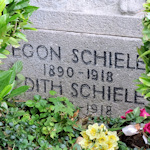
Egon Schiele studied in Vienna, produced some of his best works here, and died here in 1918.
So the artist’s name remains linked with the city, even if he wasn’t always fond of it and was actually born in Tulln (a small town about 35 minutes by car from Austria’s capital).
This overview reveals where to see Schiele’s paintings in Vienna and where to find his final studio, grave, and other important life landmarks. All the key locations appear on a map at the end of the post.
- Add a concert experience* to your Vienna trip
- See also:
Schiele: his works
Let us begin with the top choice…
The Leopold Museum

(Leopold Museum with the MQ Libelle viewing platform on its roof; © Leopold Museum, Vienna; Photo: Ouriel Morgensztern)
This should be number one on your list for exploring Schiele’s artistic output; the Leopold Museum owns the world’s most important Schiele collection, covering over 40 paintings and dozens of works on paper.
Many of these paintings, including the likes of Seated Male Nude and a Portrait of Wally Neuzil, appear in the Schiele galleries of the museum within the wider Vienna 1900 permanent exhibition.
The Leopold Museum’s special exhibitions may include some Schiele connection, too, so be sure to check the current schedule.
Belvedere

(Death and the Maiden. Photo courtesy of and © Belvedere, Wien. Reproduced with permission under the terms of Creative Commons License CC BY-SA 4.0.)
Most people associate the Belvedere art collections with Klimt, but the same location that features the famous Kiss also includes several works by Schiele.
Belvedere sometimes changes the displays around to keep things fresh, but my last trip there revealed, for example, Schiele’s portrait of Eduard Kosmack in the Vienna 1900 section and his evocative The Family and Death and the Maiden paintings in the Emerging Modernism section.
Wien Museum
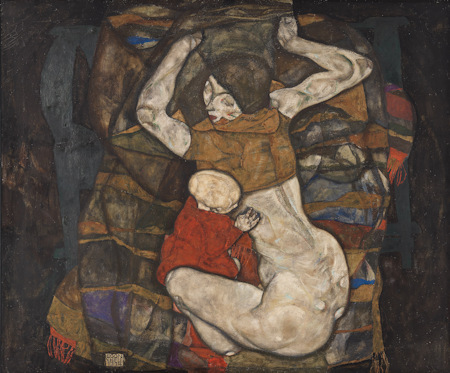
(Egon Schiele, Young Mother, 1914; Wien Museum; press photo: Birgit and Peter Kainz, Wien Museum)
The Wien Museum also owns works by Schiele and their redeveloped building on Karlsplatz has Vienna around 1900 as one of the main areas in the permanent exhibition.
I found several paintings on display in the Fin de Siècle section at the December 2023 reopening, including a 1911 self-portrait, a 1910 portrait of Arthur Roessler, his unusual 1909 Sunflower, the 1914 Young Mother (pictured above), and 1911’s The Artist’s Room in Neulengbach.
Albertina Art Museum
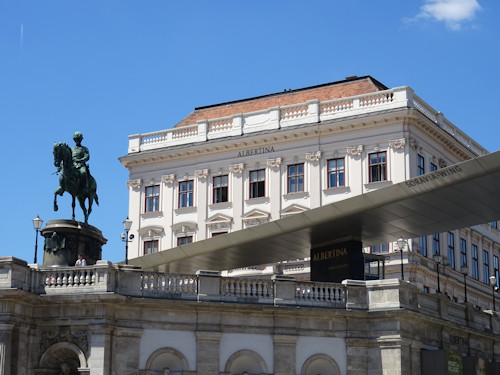
(The museum has an enormous collection of prints, paintings, and more)
The Albertina also owns a large Schiele collection (original works, photos, diaries, etc.), but most items are not on display at any one time.
You should find his paintings in the permanent exhibition. Indeed, Schiele had a whole room to himself last time I visited. (But they do change things up regularly.)
When there, check their current special exhibitions, too. You might find Schiele features strongly in one of those as well. (As was the case in, for example, 2023/2024’s Michelangelo and Beyond.)
Schiele: life and landmarks
Should you wish to follow in Schiele’s physical footsteps, then try these addresses:
Education
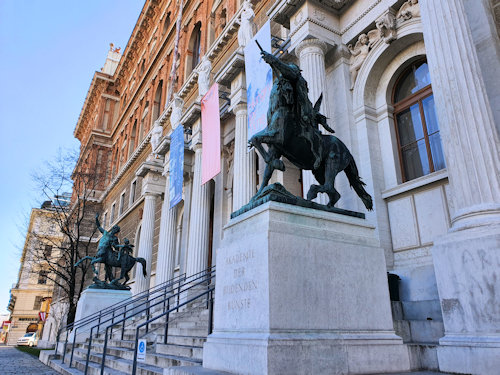
(Schiele would have ascended these steps to attend classes)
As you can imagine, Schiele took well to a classical training in art. Or perhaps not.
Anyway, he attended the Vienna Academy of Fine Arts (address: Schillerplatz 3, 1010 Vienna) from 1906 before breaking off his studies in 1909.
The Akademie der Bildenden Künste Wien is still a major university today and houses its own renowned paintings and art collection.
(This is the institution that famously rejected Hitler’s application to study there!)
Last studio
Schiele is commonly associated with Hietzing, Vienna’s upmarket 13th district.
When I visited the small Hietzing District Museum (Am Platz 2), it had an original bronze bust of the artist (designed by Schiele himself), and one of his easels. Warning: the museum has limited opening hours.
If you do go to Hietzing, consider popping over to the Klimt Villa, location of Klimt’s last studio and now a museum.
Final studio
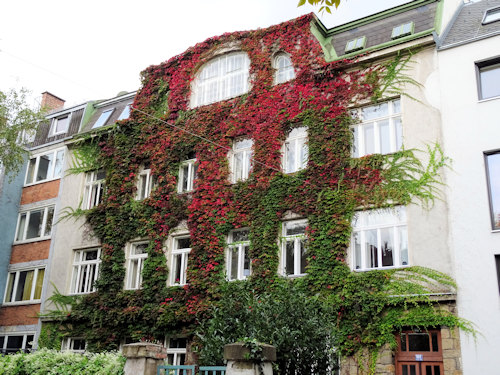
(Hietzinger Hauptstraße 101: Schiele’s studio was up in the roof)
From 1912 to his death, Schiele had a studio at Hietzinger Hauptstraße 101, directly opposite his parents-in-law’s house. A plaque next to the front gate marks the location.
Other alleged studios and residences I visited in Vienna bore no sign of their significance.
Place of death

(A plaque on the wall marks the house where Schiele died)
Schiele died on October 31st, 1918 at Hietzinger Hauptstraße 114, the home of his parents-in-law. His wife had died a couple of days earlier from the same Spanish ‘flu.
A plaque outside commemorates the event and notes that he also created many works in a nearby studio from 1912 to 1918 (see Hietzinger Hauptstraße 101 above).
Schiele’s grave

(The lower part of Schiele’s gravestone)
They buried Schiele on November 3rd, and the grave is in the Ober St. Veit cemetery at Gemeindeberggasse 26.
On the noticeboard to the left of the main entrance you’ll find a cemetery map: look for Group B, Row 10, Nr.15/16.
Basically go right at the entrance until you hit the storage huts. Then go up the next row after this and look for Schiele’s grave on the right. He’s buried with his wife, Edith.